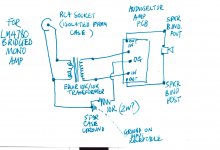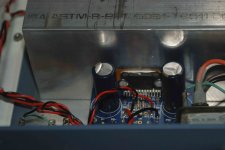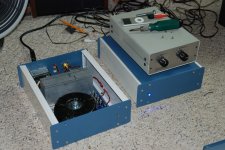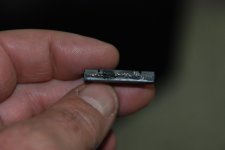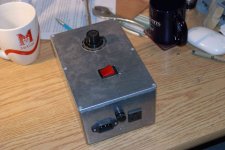Thanks Andrew
The primary is 220V
I will try the softstart. However the slo-blo fuse can be solve problem ?
Incase if not applied the relay for speaker, is there any other method to prevent the noise for speaker because I do not prefer the relay between amp and speaker.
Rgds
The primary is 220V
I will try the softstart. However the slo-blo fuse can be solve problem ?
Incase if not applied the relay for speaker, is there any other method to prevent the noise for speaker because I do not prefer the relay between amp and speaker.
Rgds
he's just told us his fuses blow at start up and you tell him he doesn't need soft start.You don't need a soft start circuit, and of course you need slow blow fuse:
That sounds a bit like recommending what is often specified on the internet (whether right or wrong) rather than taking the time to educate.
Well, I wouldn't say that if I didn't know that literally thousands of those amps have been successfully built without soft start.
And Andrew, please stop confusing people in my commercial thread; it's seems like a repeating trend now: you always have something to say, but rarely it's useful or practical information, especially when we are talking about my boards here, not chip amps in general.
If you feel the need to educate people: start your own thread.
And Andrew, please stop confusing people in my commercial thread; it's seems like a repeating trend now: you always have something to say, but rarely it's useful or practical information, especially when we are talking about my boards here, not chip amps in general.
If you feel the need to educate people: start your own thread.
Last edited:
I could choose to keep quiet and leave your thread.
I suggested that fuse blowing of a medium size transformer is due to start up current and provided a solution.
I see nothing wrong with that.
It is certainly not at odds with the build experience of both you and your customers.
I suggested that fuse blowing of a medium size transformer is due to start up current and provided a solution.
I see nothing wrong with that.
It is certainly not at odds with the build experience of both you and your customers.
is it your opinion that this response applies in this example?but rarely it's useful or practical information,
Last edited:
I think baduong has speaker thump one second after power off, rather than at power on Daniel. If this is due to less than optimal wiring, is it likely to be because of earthing, incorrect gauges of wire, routing power cables near to signal cables, or what? I ask because I have the same issue.
Many thanks
Lucas
Many thanks
Lucas
is it your opinion that this response applies in this example?
Yes, this example particularly. There were numerous posts about fuses blowing at start up and conclusion was always the same: not properly selected fuse type. Building soft start circuit that in some cases is more complicated than amp itself doesn't make much sense here.
Indeed, the thump was at turn off, it could be from caps discharging in some weired way, but normally it should not be happening with that design.
Posting some pics could help in locating the problem.
Hi,
Not sure if this is the correct place to post, but I would like to share my findings.
I have just fitted a Zobel network to the outputs of my Audiosector dual mono configured LM3875 Gainclone (premium kit). I am running 2x 18-0-18v, 120VA toroidal transformers, 2x rectifier boards with no snubber caps and unregulated to give about 24v at the rails off load. The amp is used to drive Tannoy Mercury M1 speakers, mounted on filled metal stands and spiked through carpet onto a wooden floor. I fitted high quality MIL Spec ceramic capacitors with metal film resistors with the values of 10R & 0.1uF.
I could not detect any colouration in the sound, and the treble was not rolled off in any way. In fact the treble was as clear as without the Zobels in place. One thing that did surprise me was a perceived improvement in the bass control (taughtness). I'm not sure if this is down to the modification, or external factors (mains power, background noise, room temperature etc). I will have to evaluate over a longer period.
Chris.
Not sure if this is the correct place to post, but I would like to share my findings.
I have just fitted a Zobel network to the outputs of my Audiosector dual mono configured LM3875 Gainclone (premium kit). I am running 2x 18-0-18v, 120VA toroidal transformers, 2x rectifier boards with no snubber caps and unregulated to give about 24v at the rails off load. The amp is used to drive Tannoy Mercury M1 speakers, mounted on filled metal stands and spiked through carpet onto a wooden floor. I fitted high quality MIL Spec ceramic capacitors with metal film resistors with the values of 10R & 0.1uF.
I could not detect any colouration in the sound, and the treble was not rolled off in any way. In fact the treble was as clear as without the Zobels in place. One thing that did surprise me was a perceived improvement in the bass control (taughtness). I'm not sure if this is down to the modification, or external factors (mains power, background noise, room temperature etc). I will have to evaluate over a longer period.
Chris.
Just checking
I'm almost ready to power up my 4780 bridged mono amplifiers. I need to check two things. (1) In an early post Peter Daniel stated it needed a balanced input and provided a circuit diagram. I figured I could put the transformer in the amplifier case and use the attached circuit, so I thought I'd check with Peter (or anyone else) that this would be OK. (2) I send the OG from the amplifier board to the case ground point and use a 10R resistor at that point. Does it matter what the wattage of the resistor is? I was thinking of using 1W or 2W.
I'm almost ready to power up my 4780 bridged mono amplifiers. I need to check two things. (1) In an early post Peter Daniel stated it needed a balanced input and provided a circuit diagram. I figured I could put the transformer in the amplifier case and use the attached circuit, so I thought I'd check with Peter (or anyone else) that this would be OK. (2) I send the OG from the amplifier board to the case ground point and use a 10R resistor at that point. Does it matter what the wattage of the resistor is? I was thinking of using 1W or 2W.
Attachments
I wouldn't connect RCA ground to chassis. You can install a toggle switch between RCA ground and SG pad on amp board and have it either open for input ground floating (not connected) or closed for hard wired grounds (connected). You may notice slight difference with each setting.
1W or 2W resistor would be fine.
1W or 2W resistor would be fine.
I just noticed it's LM4780 bridged amp. In that case the grounds need to be hardwired (permanently connected) so just run it directly from RCA to SG pad. It was discussed here: http://www.diyaudio.com/forums/showthread.php?t=149617
Thank you again. I had seen that thread but I hadn't made the connection (!) I recall from a post somewhere that the SG is connected to the OG on the amplifier board (as the diagram shows) and I now see that connecting the RCA ground directly to the case ground might just introduce the possibility of a hum/loop.
hello all
just want to show my amp.
Dual mono kit, LM4780, parallel
single 2x21V torroidal, 300VA
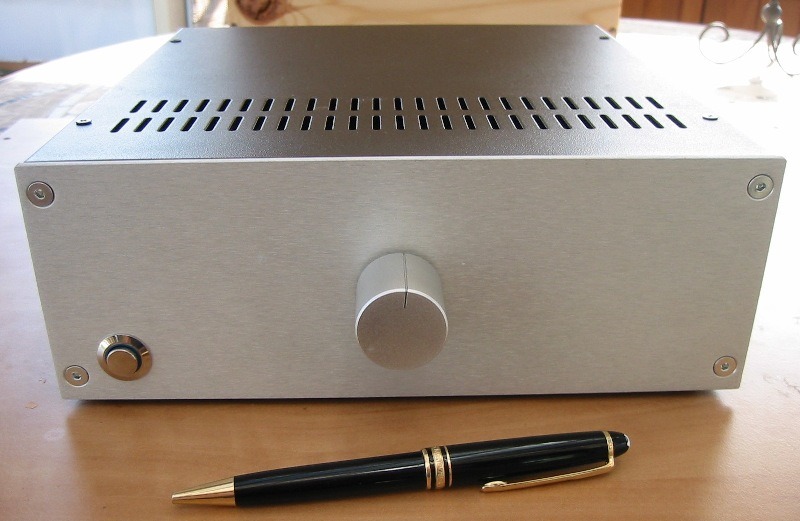
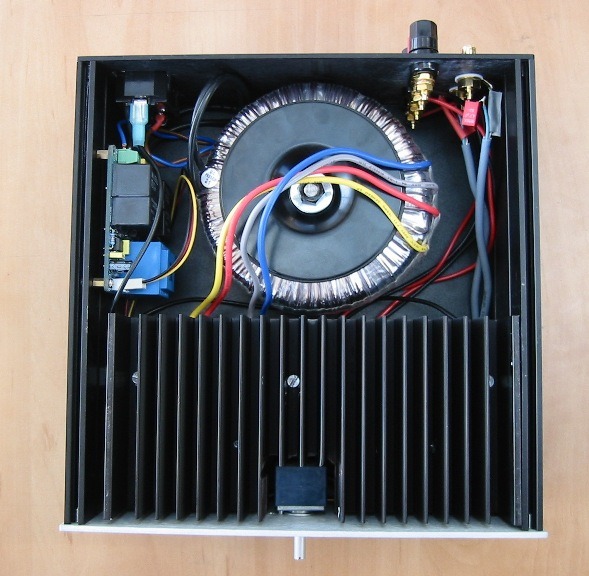
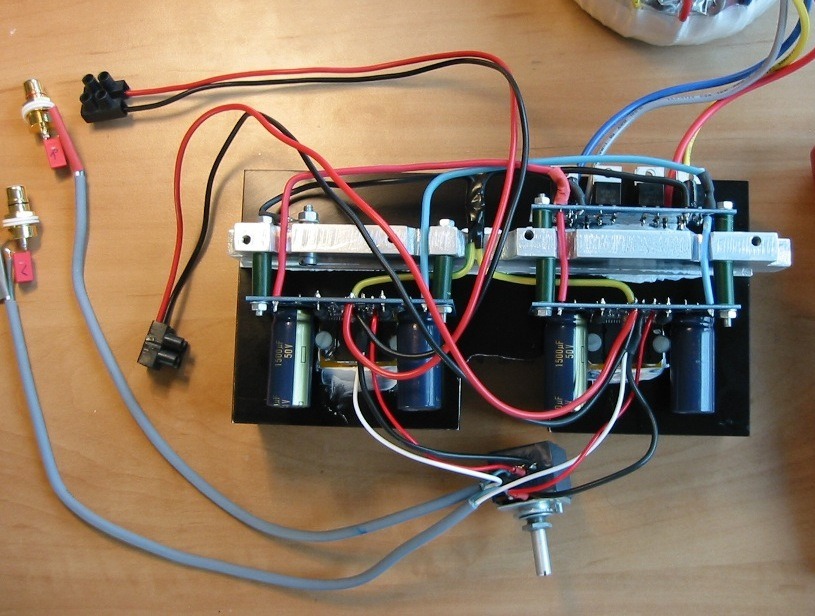
the plan
offset 23,4mV (right channel) and 15,1mV (left)
no hum at all
It looks good, is small and sounds great, but I am quite disapointed by its power. Also short on bass for my taste.
I expected more power in my 4ohm Zaph SR71 diy loudspeakers.
I will upgrade with a 2x24V torroidal and add 4x10 000 µF capacitors in parallel to the 10µF on the rectifier board.
BTW, yes I blew up the chips and capacitors when I first mounted the MUR diodes reverse on the rectifier !!
just want to show my amp.
Dual mono kit, LM4780, parallel
single 2x21V torroidal, 300VA
the plan
An externally hosted image should be here but it was not working when we last tested it.
offset 23,4mV (right channel) and 15,1mV (left)
no hum at all
It looks good, is small and sounds great, but I am quite disapointed by its power. Also short on bass for my taste.
I expected more power in my 4ohm Zaph SR71 diy loudspeakers.
I will upgrade with a 2x24V torroidal and add 4x10 000 µF capacitors in parallel to the 10µF on the rectifier board.
BTW, yes I blew up the chips and capacitors when I first mounted the MUR diodes reverse on the rectifier !!

Last edited:
BTW, yes I blew up the chips and capacitors when I first mounted the MUR diodes reverse on the rectifier !!
Really nice work there!
And thanks for the laugh!
Hi Peter. Two weeks ago I was planning to build a gainclone with your LM4780 kit in bridge mode. But it was before I read all this thread.
You say that: -In my experience, bridged is better, but you need a balanced source and be sure that speaker impedance does not go below 8 ohm. Otherwise you have no choice but to go paralleled.
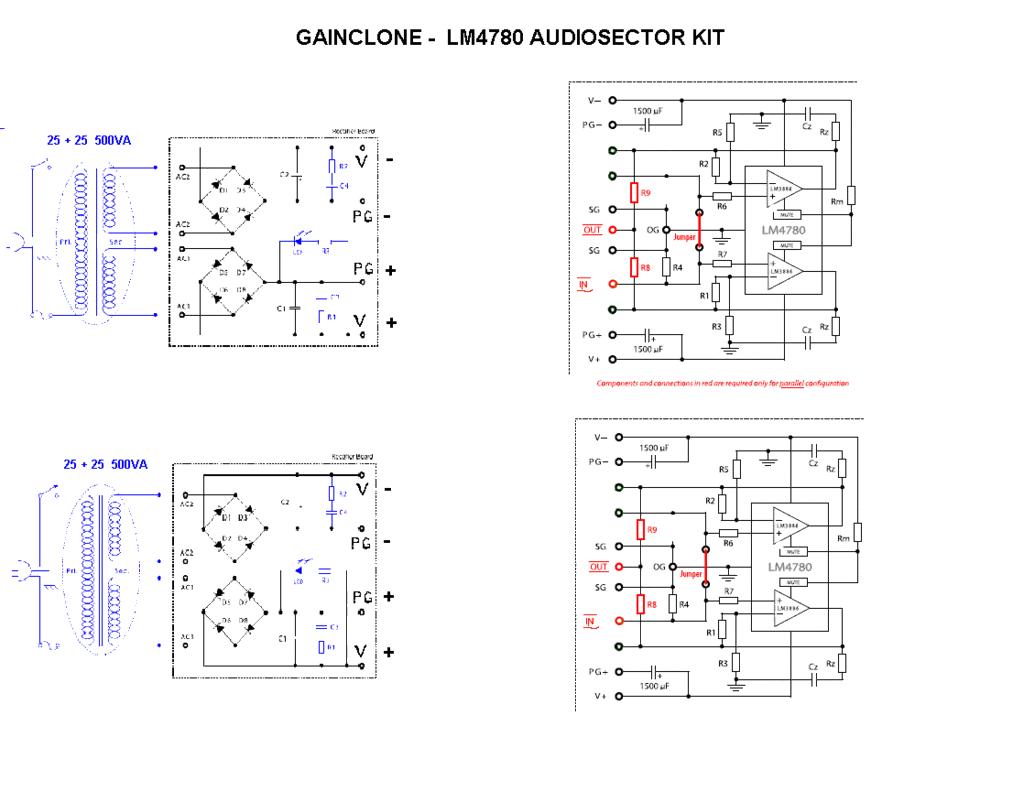
Theoricaly my speakers are 8 ohms but in reality:
- Strictly Superior to 4.5 Ohms (115Hz and 17.8KHz)
- Average 6,5 Ohms - Ecart Type 0,98 (between 20Hz-22Khz)
- 90% of time superior to 5.4 ohms
- Max peak at 48Hz (19.5 Ohms)
So I have decided to go in parralel mode with 2 transformers. I'm planing to put 2 Antek transformers AN5225 (500 Va 25/25volts) because in the specs of National it seems that there is more power with 35 volts.
My concern is about the power dissipation. Is there a risk that I burn the amp if the voltage is 35 volts instead of 25.
Do you have any hint on the heat sink issue.
Thanks Peter.
You say that: -In my experience, bridged is better, but you need a balanced source and be sure that speaker impedance does not go below 8 ohm. Otherwise you have no choice but to go paralleled.

Theoricaly my speakers are 8 ohms but in reality:
- Strictly Superior to 4.5 Ohms (115Hz and 17.8KHz)
- Average 6,5 Ohms - Ecart Type 0,98 (between 20Hz-22Khz)
- 90% of time superior to 5.4 ohms
- Max peak at 48Hz (19.5 Ohms)
So I have decided to go in parralel mode with 2 transformers. I'm planing to put 2 Antek transformers AN5225 (500 Va 25/25volts) because in the specs of National it seems that there is more power with 35 volts.
My concern is about the power dissipation. Is there a risk that I burn the amp if the voltage is 35 volts instead of 25.
Do you have any hint on the heat sink issue.
Thanks Peter.
35V rails is not a problem. The chips are fully protected, including overheating:
The LM4780 is fully protected utilizing National’s Self Peak
Instantaneous Temperature (°Ke) (SPiKeTM) protection circuitry.
SPiKe provides a dynamically optimized Safe Operating
Area (SOA). SPiKe protection completely safeguards the
LM4780’s outputs against over-voltage, under-voltage, overloads,
shorts to the supplies or GND, thermal runaway and
instantaneous temperature peaks. The advanced protection
features of the LM4780 places it in a class above discrete
and hybrid amplifiers.
The required heatsink size will depend on the speakers, the usual volume level and type of music played. In most cases, metal enclosure is all you really need, without a need for additional heatsinks.
The LM4780 is fully protected utilizing National’s Self Peak
Instantaneous Temperature (°Ke) (SPiKeTM) protection circuitry.
SPiKe provides a dynamically optimized Safe Operating
Area (SOA). SPiKe protection completely safeguards the
LM4780’s outputs against over-voltage, under-voltage, overloads,
shorts to the supplies or GND, thermal runaway and
instantaneous temperature peaks. The advanced protection
features of the LM4780 places it in a class above discrete
and hybrid amplifiers.
The required heatsink size will depend on the speakers, the usual volume level and type of music played. In most cases, metal enclosure is all you really need, without a need for additional heatsinks.
Finished at last
Two bridged mono LM4780s. They work. (Except I forgot to get feet, so they balance on the transformer mounting bolt). This (and related threads) have been really useful.
Two bridged mono LM4780s. They work. (Except I forgot to get feet, so they balance on the transformer mounting bolt). This (and related threads) have been really useful.
Attachments
- Home
- More Vendors...
- Audio Sector
- Commercial Gainclone kit- building instructions
